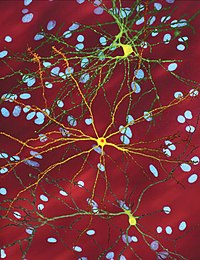
Photo from wikipedia
ObjectiveI-123-2β-Carbomethoxy-3β-(4-iodophenyl)-N-(3-fluoropropyl)nortropane (FP-CIT) imaging is an established biomarker used in the diagnosis of Lewy body disease. Images are often reported with the aid of striatal binding ratios (SBRs), comparing uptake to… Click to show full abstract
ObjectiveI-123-2β-Carbomethoxy-3β-(4-iodophenyl)-N-(3-fluoropropyl)nortropane (FP-CIT) imaging is an established biomarker used in the diagnosis of Lewy body disease. Images are often reported with the aid of striatal binding ratios (SBRs), comparing uptake to a normal database via Z scores. It is well known that SBRs are age dependent. However, previous studies cover wide age ranges between 20 and 80 years, rather than focusing on older adults. Typically a linear relationship is reported, but some authors have suggested that SBRs do not decline as rapidly in old age. Commercial software packages usually adjust the SBR Z score to attempt to compensate for age-related decline, but the model used varies. Ensuring age correction is appropriate for older adults is important, given that the majority of patients referred for FP-CIT scans are aged over 60 years. We examined the relationship of SBR with age in older adults and the effect of age correction using research scans from 123 adults over 60 years of age.MethodsTwenty-nine healthy older adults and twenty-three with MCI due to Alzheimer’s disease were included as controls, i.e. individuals with no evidence of Lewy body disease. Their ages ranged from 60 to 92 years (mean 76; SD 7.9). SBRs and Z scores were calculated using BRASS (Hermes Medical) and DaTQUANT (GE Healthcare). SBRs were plotted against age and linear mixed effect models applied. We tested the effect of removing age correction in BRASS using an independent dataset of 71 older adults with dementia or mild cognitive impairment.ResultsThe slopes of the linear fits between SBR and age per year were − 0.007 (p = 0.30) with BRASS and − 0.004 (p = 0.35) with DaTQUANT. The slopes are smaller than reported in the literature and show no statistically significant difference from zero. Switching age correction off in BRASS in the test subjects reduced Z scores by approximately 1 standard deviation at 80 years of age.ConclusionWe found no statistically significant age-related decline in SBR in adults over 60 years of age without Lewy body disease. Commercial software packages that apply a fixed rate of age correction may be overcorrecting for age in older adults, which could contribute to misdiagnosis.
Journal Title: Annals of Nuclear Medicine
Year Published: 2019
Link to full text (if available)
Share on Social Media: Sign Up to like & get
recommendations!